-
PDF
- Split View
-
Views
-
Cite
Cite
Frederique Ponsar, Katie Tayler-Smith, Mit Philips, Seco Gerard, Michel Van Herp, Tony Reid, Rony Zachariah, No cash, no care: how user fees endanger health—lessons learnt regarding financial barriers to healthcare services in Burundi, Sierra Leone, Democratic Republic of Congo, Chad, Haiti and Mali, International Health, Volume 3, Issue 2, June 2011, Pages 91–100, https://doi.org/10.1016/j.inhe.2011.01.002
Close - Share Icon Share
Abstract
Although user fees are a common form of healthcare financing in resource-poor countries, there is growing consensus that their use compromises health service utilisation and population health. Between 2003 and 2006, Médecins sans Frontières (MSF) conducted population-based surveys in Burundi, Sierra Leone, Democratic Republic of Congo, Chad, Haiti and Mali to determine the impact of user fees on healthcare-seeking behaviour and access. For general and disease-specific conditions, MSF also measured the impact of (i) reduced payment systems in Chad, Mali, Haiti and Burundi and (ii) user fee abolition for certain population groups in Burundi and Mali. User fees were found to result in low utilisation of public health facilities, exclusion from health care and exacerbation of impoverishment, forcing many to seek alternative care. Financial barriers affected 30–60% of people requiring health care. Exemption systems targeting vulnerable individuals proved ineffective, benefiting only 1–3.5% of populations. Alternative payment systems, requiring ‘modest’ fees from users (e.g. low flat fees), did not adequately improve coverage of essential health needs, especially for the poorest and most vulnerable. Conversely, user fee abolition for large population groups led to rapid increases in utilisation of health services and coverage of essential healthcare needs. Abolition of user fees appears crucial in helping to reduce existing barriers to health care. The challenge for health authorities and donor agencies is around working creatively to remove the fees while addressing the financial consequences of improved access and providing quality care.
1 Introduction
User fees (out-of-pocket payments at the point of care) are a common feature of health system financing in resource-poor countries, particularly in African countries.1 In general, some form of fee is paid by the patient for curative care services at the point of use.
The introduction of user fees in African countries was largely driven by the Bamako Initiative in the 1980s that advocated for cost sharing and community participation to try to increase efficiency and equity and to improve the financial viability of health facilities.2 However, the practice of user fees has generated mixed results. Concerns over equity were raised early on,3,4 and many health systems appear to have relied too heavily on the financial participation of users, compromising healthcare access and living standards.3–5
In the course of evaluating its programmes, Médecins sans Frontières (MSF) has conducted a number of studies in various countries [Burundi, Sierra Leone, Democratic Republic of Congo (DRC), Chad, Haiti and Mali] to determine the degree of exclusion from primary health care and the underlying reasons for this exclusion.6 Across these contexts (some stable, some in conflict and post conflict, and despite differences in the programmes) some common patterns have emerged regarding user fees and the impact of reduced payment systems for health services. For the six countries mentioned above, this study (i) describes the adverse effects of user fees and (b) discusses the health policy implications in terms of health financing in resource-poor settings.
2 Methods
2.1 Study settings
The study settings comprised rural areas served by health centres in Burundi, Sierra Leone, DRC, Chad, Haiti and Mali. MSF was present in all of the settings prior to the studies, providing mainly primary and secondary healthcare support. At the time of the studies some settings were in conflict (DRC), some were post conflict (Burundi and Sierra Leone) and some were stable (Chad, Haiti and Mali). In all areas, poverty was widespread and health indicators were very poor.7–13 Details of the study settings across the six countries are shown in Table 1 .
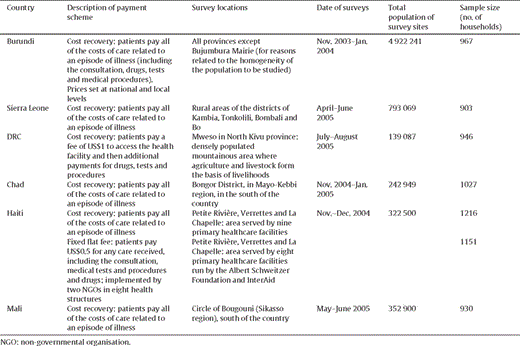
Geographical and population coverage of population surveys conducted in Burundi, Sierra Leone, Democratic Republic of Congo (DRC), Chad, Haiti and Mali.
2.2 Description of the different payment systems assessed
2.2.1 Cost recovery schemes
A cost recovery payment system was in place in most public health facilities across the six countries studied, with patients having to pay for every component of medical care (Table 1).
2.2.2 Schemes involving partial abolition of payment
2.2.2.1 Exempting indigents and lowering fees (Burundi)
In 2003, MSF introduced a system for identifying the poorest of the population in Karuzi Province, Burundi, who were then exempt from any payment for health services. In addition, a low all-inclusive flat fee was introduced for the population who did not qualify for exemptions.14 Whilst a pre-existing exemption system identified individuals for exemption on a case-by-case basis at the health facility, the new system used local ‘health committee’ members to identify households for exemption according to set socioeconomic criteria, at the community level, prior to healthcare-seeking. MSF subsidised all the costs related to exemptions. This removed any conflict of interest for health staff who may have been reluctant to grant exemptions that would reduce health centre income.
2.2.2.2 Subsidised malaria treatments (Mali)
In Kangaba Circle, Mali, MSF worked with the health authorities in 2005 to introduce artemisinin-based combination therapy (ACT) at seven community health centres and one referral health centre (for inpatients),15 covering a population of just over 70 000. Rapid diagnostic tests (RDT) and ACT were offered free of charge to children under five and at a subsidised rate of US$0.17 for all other persons.
2.2.2.3 Lowering fees/introducing flat fees (Haiti)
In Haiti, a subsidised, low flat fee was implemented at the Albert Schweitzer Hospital, its related health centres and InterAid health facilities, with patients paying US$0.5 for any care or treatment received (see Table 1).
2.2.3 Complete abolition of user fees for certain population groups
2.2.3.1 Burundi
From 2003, MSF supported ten health centres and one referral hospital in Karuzi. As described above, until April 2006 patients had to pay an all-inclusive, low flat fee, with an improved exemption scheme in place to cover the most vulnerable. In May 2006, a new national policy was implemented to provide free care for pregnant women and children under five.
2.2.3.2 Mali
In Mali, the MSF malaria project described above was revised in December 2006 and MSF began providing free care for children under five with any disease and for pregnant women with any case of fever. In addition, everyone aged > 5 years benefited from a reduced, all-inclusive flat fee for any case of fever, subsidised by MSF.
In Mali and Burundi, supervision and regular exit surveys were used to monitor the systems and to ensure provision of free care for those entitled to it.
2.3 Data collection
2.3.1 Population surveys
Population-based surveys were used to assess the impact of cost recovery systems in place across all six countries as well as the low flat-fee system implemented in parts of Haiti (see Table 1). These surveys were conducted between 2003 and 2006 using a two-stage cluster sampling method (30 clusters of 30 families).16 Details of survey methodology in the different countries are referenced.7–13 The main objective was to measure people's access to primary health care and to evaluate financial barriers to healthcare utilisation in public health centres. Household members were interviewed in areas within a 5 km radius of a health centre. This radius was chosen so as to focus on barriers to healthcare access besides geographical ones.
Survey questions focused on mortality, health-seeking behaviour during the last episode of illness (taking into account any illness where a medical consultation was deemed necessary by the family) and methods of payment for services at the health facility. Specific causes of morbidity and mortality were ascertained from the household member interviewed. Questions on healthcare access applied only to those households with at least one person ill during a preceding period of 3 months in Burundi, DRC, Haiti and Mali and 3–5 months in Sierra Leone and Chad. Socioeconomic data were collected, including whether the household held any exemption card for health care, household income and healthcare expenditure, together with mechanisms employed by households to deal with health-related expenditure. The average cost of care for one visit to the nearest health centre was calculated and the average number of days of income required to pay this cost was determined. In addition to the household surveys, complementary data were gathered through interviews with different health actors.
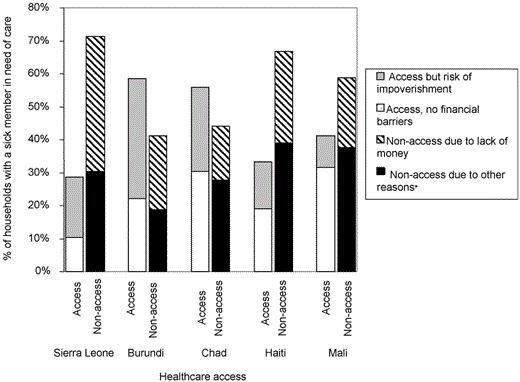
Case definitions of specific terms used in this paper are shown in Box 1
2.3.2 Routine health centre data
Routine health centre data were used to measure the impact (utilisation rates and mortality) of the reduced payment schemes and the abolition of user fees for certain population groups in Burundi and Mali.
3 Main findings
3.1 Mortality and poverty indicators
Table 2 shows mortality rates and poverty indicators for the different populations surveyed. In all settings, crude mortality and under five-mortality rates were alarmingly high, exceeding emergency thresholds in all or some parts of the countries.17 The most common causes of mortality were communicable diseases, mainly fever/malaria, diarrhoea and acute respiratory infections, with fever/malaria being the leading cause of death reported.

Mortality rates and poverty indicators for Burundi, Sierra Leone, Democratic Republic of Congo (DRC), Chad, Haiti and Mali.
The majority of households surveyed in the six countries lived below the extreme poverty threshold of US$1/person/day.
3.2 Adverse consequences of user fees
3.2.1 Exclusion from health care and low utilisation of public health services
Table 3 shows levels of healthcare utilisation and related financial factors for households in the six countries. Between 7% and 23% of households were found to be completely excluded from health care. Lack of money was the main reason (65–92% of households). Among those households with a sick member, 32–62% sought care from their nearest health centre. Among those who sought care elsewhere (either at other official health structures or in the alternative sector), the main reason for not seeking care at their nearest health centre was lack of money (21–54%). Other reasons included inconvenience, cultural or social habits, issues of trust and undesirable conditions at the health centre (e.g. long waiting times, drug shortages, staff shortages).
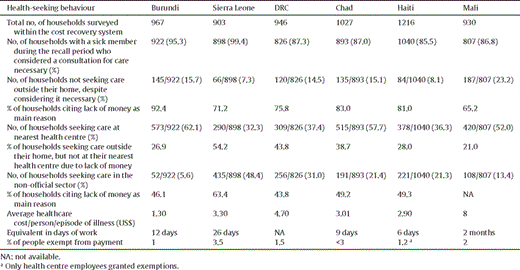
Household and financial factors related to utilisation of health services (cost recovery system) in Burundi, Sierra Leone, Democratic Republic of Congo (DRC), Chad, Haiti and Mali.
3.2.2 High use of alternative care
A variable proportion of households surveyed (6–48%) sought treatment from alternative providers. Although the reasons above were commonly cited, lack of money was the leading reason for using alternative care providers (Table 3).
3.2.3 Impoverishment
Poverty was widespread in the areas surveyed, with 80–99% of households living below the extreme poverty line. It took on average 6–60 days of income to cover the cost of one visit to a primary healthcare facility (Table 3). Up to 50% of people had to sell personal possessions (food reserves, cattle, land) or borrow money to pay for health care. This placed them at greater risk of further impoverishment and often rendered households unable to pay for future care or for other essential household expenses.
3.2.4 Healthcare access related to financial barriers
Figure 1 illustrates the degree to which financial barriers influenced health-seeking behaviour in Sierra Leone, Burundi, Chad, Haiti and Mali. Among all those households with a sick member requiring a consultation, 14–36% paid for health care at their nearest health centre by coping mechanisms that actually placed them at further risk of impoverishment (Figure 1). Taking these households into account, together with those who did not access care owing to lack of money, financial barriers were present for 30–60% of people (Figure 1).

Financial barriers affecting health-seeking behaviour in Burundi, Sierra Leone, Chad, Haiti and Mali. * ‘Other’ reasons for non-access include geographical barriers, lack of transport, lack of drugs at the health centres, long waiting times at the health centres, lack of confidence in the health centre staff, staff shortages at the health centre.
3.2.5 Ineffective exemption systems for the most vulnerable
Despite the extreme poverty and vulnerability of many households surveyed, only 1–3.5% benefited from fee exemptions for curative care at their nearest health centre (see Table 3). In some surveys, those benefiting from exemptions were not always the most in need. For example, in Haiti only 13 people were exempt from payment for health care and all were health centre employees with no link to vulnerability.
3.2.6 Inappropriate services
Based on interviews with key health actors, it was reported that in some health facilities there was overprescribing of drugs, tests and certain procedures in order to generate greater revenue. In Burundi, for example, many healthcare workers prescribed quinine for malaria even though ACT was available; prescribing quinine tripled financial revenue.
3.3 Inadequacy of schemes involving partial abolition of payment
3.3.1 Exempting indigents and lowering fees (Burundi)
With this system of community identification of vulnerable households, 15% of households qualified for exemptions (compared with 2–3% in other areas outside the scheme) and all those entitled to free care received this when they attended the health centres.14 With the combined system of exemptions and low flat fee, utilisation rates at the health centres increased between 2003 and 2005 (Figure 2 ) (P < 0.001), mainly due to more indigents accessing care. A survey conducted in 200514 revealed that financial access to care at the nearest health centre was ensured for 70% of the population. However, of the remaining 30%, one-half still experienced financial barriers and the other one-half chose alternative sites for care. Among non-exempt households accessing care at the nearest health centre, 87% reported having no money available at the time of illness and 25% risked further impoverishment because of healthcare costs, even with the financial support system in place.
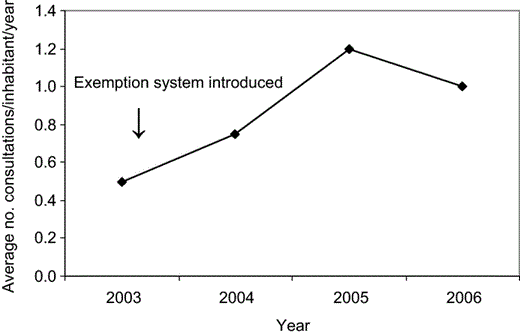
Impact of household payment exemption on health centre utilisation rates, Karuzi, Burundi.
3.3.2 Subsidised malaria treatments (Mali)
From 2005 to 2006 with free or subsidised malaria treatment and diagnosis, malarial cases treated in the health centres increased by 20% from 0.1 to 0.12 treated malaria cases/inhabitant/year (χ2 = 92.36, P < 0.001). For under fives, treated malaria cases increased from 0.25 to 0.38 cases treated/child/year (χ2 = 474.36, P < 0.001). However, actual coverage for malaria (i.e. attendance at a health centre and receiving treatment) remained very low compared with the number of expected malaria cases estimated by national data (one or two episodes per person per year, depending on the age group18). This was despite (i) the health centres being staffed with qualified personnel who were well supervised and (ii) effective malaria drugs and diagnostics being available free of charge.
3.3.3 Lowering fees/introducing flat fees (Haiti)
In areas where a low flat fee applied, 69% of people surveyed had access to complete treatment at their nearest health centre compared with 33% where the cost recovery system applied in public facilities (P < 0.001). In addition, significantly more people living around health centres applying cost recovery mechanisms sought alternative care (57%) compared with people living around health centres charging a low flat fee (20%) (P < 0.001). However, even with the low flat fee, 8% of people surveyed were excluded from any health care (with lack of money reported as the main reason) and 47% of households accessed care at their nearest health centre but through the use of financial coping mechanisms (such as selling goods, land or harvest or going into debt), which placed them at further risk of impoverishment.
3.4 Complete abolition of user fees
3.4.1 MSF experience in Burundi
After the introduction of free care for pregnant women and children under five in 2006 in health centres in Karuzi, large increases in service utilisation followed. For under-fives, consultations in Karuzi increased from an average of 9000 per month in the year preceding the introduction of free care to an average of 13 000 per month in the year that followed its introduction, and attendance rates increased from 1.6 to 2.2 contacts/child/year across the same time frame.
3.4.2 MSF experience in Mali
In comparison with the first phase of the MSF project (free RDTs and ACT for children under five and at a subsidised cost for all other persons), the introduction of free care for children under five and for pregnant women with fever had remarkable results. Curative consultations linked to confirmed malaria cases trebled between 2006 and 2007. Among children under five, cases of treated malaria increased 3.5 times from 0.38 to 1.28 new cases per child per year, representing 64% coverage of total needs compared with <20% coverage in the first phase of the project (Figure 3 ). Five times more pregnant women were treated for malaria. Furthermore, across the health centres the malaria fatality rate fell from 0.35% in 2006 to 0.03% in 2007 (χ2 = 197.23, P < 0.001). Curative consultations linked to all complaints also increased substantially, increasing five-fold for children under five and trebling for pregnant women (Figure 4 ).
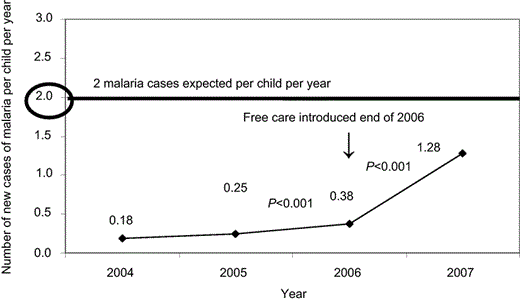
Health centre utilisation rates for malaria treatment among children under five before and after the removal of user fees in the Kangaba Circle, Mali.
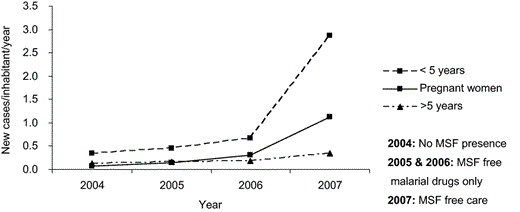
All consultations according to different population groups before and after user fee removal in the Kangaba Circle, Mali. MSF: Médecins sans Frontières.
4 Discussion
There is extensive literature on the impact of user fees in low-to-middle income countries,1,3–5,19–22 and the subject of their removal, particularly in Africa, is now a heavily debated issue. The findings of the various studies reported in this paper show that in contexts where poverty is widespread, user fees represent a major obstacle to the use of essential health services and exacerbate impoverishment. Furthermore, their removal leads to marked improvements in terms of coverage of essential health services. These findings support the removal of user fees. The challenge for health authorities is to ensure that alternative financing mechanisms guarantee healthcare access and financial protection for patients while assuring the quality of services through sufficient human resources and supplies to respond to the increased case loads related to increased access.
The main strengths of the data from the surveys reported in this paper are that (i) data are population-based and therefore better reflect the reality than health centre data alone, (ii) the problems of user fees are demonstrated across multiple contexts and (iii) there are no major confounding factors identified that may have influenced the study findings. There are, however, a number of limitations: (i) the surveys were limited to population groups living <5 km from a healthcare centre, thus the results may have underestimated levels of poverty and financial exclusion to primary health care; (ii) as interviewers were from a non-governmental organisation, this may have influenced participants’ responses leading to under-reporting or over-reporting on certain topics; (iii) owing to the relatively short time scale and small geographical coverage for evaluating the impact of user fee reduction or removal, the results may not reflect the situation observed in the longer- term and across other geographical regions; and (iv) the data do not allow intercountry comparisons as the populations and contexts differ. This notwithstanding, the findings from this paper raise a number of arguments that merit discussion.
First, the findings illustrate how user fees impact negatively on the demand for primary health care and exclude a substantial proportion of people from care. They add to the evidence that financial barriers associated with user fees contribute significantly to low utilisation of health services.20–25 Under-use of health services is strongly associated with high mortality rates when one considers that a substantial number of deaths are preventable through access to effective health interventions.26–30 Direct healthcare costs at the point of use are not the only barriers to access. Other direct and indirect costs, such as transportation, food expenditures, loss of time, distance, cultural factors, education and perception of low quality care at health centres are among other barriers to healthcare access in resource-poor contexts,26,31,32 some of which were reported in the current surveys. Thus, user fee removal alone is unlikely to be enough to tackle the problem of healthcare access. However, it is an important first step and should be addressed.
Second, the findings show how user fees force many sick patients to seek cheaper alternatives. Although alternative providers may offer lower costs, flexible payment systems and care that is more convenient, the drugs they use may be unsafe or wrongly prescribed and the sellers may be inadequately qualified. Patients may thus be exposed to ineffective treatment and adverse or toxic effects. The current findings show that lack of money, rather than cultural beliefs, was the main reason why people sought alternative care.
Third, although the countries studied are in a stable situation or are emerging from crises and moving towards a ‘development phase’, their populations are still highly vulnerable, with mortality rates exceeding emergency thresholds and with most people still living below the extreme poverty threshold. The current findings show that user fees often increase the risk of further impoverishment for many vulnerable households. This is in line with other studies from resource-poor settings33 that demonstrate the diminishing likelihood of a poor household ever being able to move out of poverty when confronted with illness-related costs.34 Given the known association between poverty and health,26 the removal of financial barriers to seeking care would seem a key strategy to be adopted for reducing high mortality rates and poverty.
Fourth, although exemption systems should enable healthcare access to those unable to pay, the current findings showed that this was not the case. Failure of these systems is often due to: (i) reluctance by healthcare workers to grant exemptions owing to insufficient subsidies to health centres to offset the loss of income from fees; (ii) difficulty managing the systems because of ambiguous operational criteria; and (iii) exemptions being granted only for those attending health centres.24 Thus, many patients, unsure whether or not an exemption will be granted, choose not to seek care. Furthermore, household income levels vary over time leading to changes in their eligibility for exemption. The constant re-assessment required to ensure a dynamic and inclusive exemption system and the associated transaction costs are practically difficult and inefficient. Our experience reflects other studies which show that even when well implemented, exemption systems based on individual or household targeting, in contexts where a large proportion of the population is too poor to pay, do not include all those in need of financial assistance to access care.35,36
Fifth, MSF experience has shown that in contexts with widespread poverty, alternatives to cost recovery systems that incur even a modest fee from service users (e.g. a low flat fee, free drugs but continued payment of other treatment costs, and targeted household or individual exemptions) continue to act as a financial barrier to healthcare access for some, especially the poorest and most vulnerable. This was confirmed by the current findings showing that where fees were abolished for certain population groups, utilisation rates increased dramatically. It could be argued that it was not the introduction of free care so much as the quality of care offered in MSF-supported facilities that attracted more users. However, MSF was present in all health facilities before free care was introduced, reinforcing the evidence that the increase in utilisation rates was most likely a result of the introduction of free care.
The importance of user fee removal in resource-poor countries seems very clear and, indeed, many African countries have moved in this direction. Some have adopted a nationwide abolition of user fees for key healthcare services (e.g. Uganda, South Africa, Kenya, Liberia, Ghana and Zambia); others have taken a more targeted approach focusing on subcategories of the population (e.g. free care for deliveries and for children under five years in Burundi, and free care for under-fives in Niger and Sierra Leone).
The challenge is around the effective implementation of user fee removal at the national level. First, the loss of income for health structures needs to be covered by alternative sources of funding. Second, increased use requires increased investment in human resources and supplies otherwise the increased access does not provide better service.37 User fee removal in several African countries has made more acute the pre-existing challenges faced by under-funded health systems, the key elements being a functioning drug supply system and human resources. Falling quality of care (often related to drug shortages), staff difficulties in managing increased workloads, loss of fee revenue used to supplement staff salaries, and poor monitoring are among some of the reported problems.37–41
User fee removal can be implemented successfully providing that there is compensation of health facilities for lost revenue as well as adequate provision of additional resources to meet the increased demand for health care.37,38,41,42 This will require commitments and investment by international donors and national governments. Governments of low-income countries need to be supported in introducing or strengthening alternative financing mechanisms that ensure timely access and financial protection for those most in need of health care.37,43 There has been a recent shift in debate towards mechanisms that encourage pre-payment and tax funding,43 although the importance of ensuring that these systems do not continue to rely on payment from those too poor to pay is essential.44
In conclusion, the findings of MSF's studies across a range of countries are very clear: user fees negatively impact on healthcare access and population health and their removal leads to better access to health services and reduced mortality. We join a growing call for the removal of user fees in settings where morbidity and mortality are high. This challenge needs to be urgently taken up by donors and policy-makers striving to achieve better coverage of essential health services, improve population health and ensure a more efficient allocation of resources.
Authors’ contributions
FP, MP and MVH were involved in the design, implementation and supervision of the surveys used in this study; FP, SG, TR, KT-S and RZ were involved in analysis and interpretation of the data collected; FP, KT-S and TR were involved in drafting the first version of the manuscript, and all authors contributed to subsequent revisions of the manuscript to improve its intellectual content. All authors read and approved the final version. FP is guarantor of the paper.
Funding
Funding for the surveys and for this article was part of the MSF budget; no external funding was sought.
Conflicts of interest
None declared.
Ethical approval
The surveys and analyses on which this article was based were carried out as part of programme evaluation with local and national health authority approval. Patient confidentiality was maintained and the results were shared with local health authorities.
Acknowledgements
The authors are grateful to all the families and patients who agreed to be interviewed for the purpose of the surveys across Burundi, Sierra Leone, Democratic Republic of Congo, Chad, Haiti and Mali. They are also grateful to the different health authorities who gave their support, together with the wide range of health actors who provided helpful contributions. Finally, sincere thanks goes to the teams in the field, the teams of interviewers and all personnel who were involved in facilitating the field work.




Comments